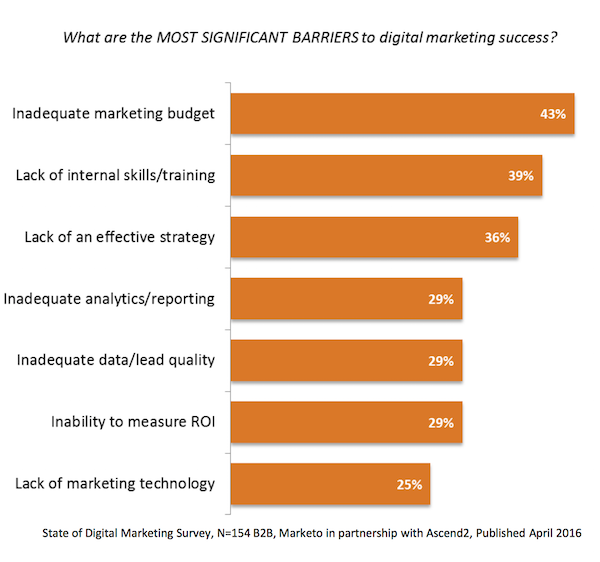
I acknowledge: finding, learning about, and integrating new marketing technologies is a challenge for marketers today. But as a new report from Wrike shows — How Marketers Get Things Done: The State of Agile Marketing in 2016 — it’s not the top challenge. It’s fifth. And a good ways below the top challenge.
The top five challenges marketers face:
- Developing creative, innovative campaigns that stand out in the market (37.2%)
- Moving fast enough to keep up with market changes and competitors (25.9%)
- Driving more revenue or sales for the company (24.7%)
- Doing more with fewer people and smaller budget than needed (24.4%)
- Finding, learning about, and integrating new marketing technologies (22.4%)
Based on my interactions with hundreds of marketers, these stats ring true.
I find that many commentators on the marketing technology landscape are quick to point out the problems there — too many choices and too much work to connect the pieces together — without stepping back to realize the context in which this landscape exists.
There’s a reason why there are so many vendors. And there’s a reason why marketers continue to purchase them and assemble marketing stacks tailored to their business.
And it’s not “shiny object syndrome.”
The explosion of marketing technology is a direct result of marketers striving to stand out in the market, keep up with market changes, drive more revenue, and be more effective with fewer resources.
The 5th most pressing challenge identified in Wrike’s study is a side effect of the first four challenges in front of it.
There are two other data points from the Wrike report that are important to note.
First, as a follow up to my post Did Morgan Stanley just kill the single-vendor marketing suite?, the majority of participants in Wrike’s study acknowledge that they use multiple tools:


Those stats include small marketing teams, which are more likely to to use fewer tools.
When Wrike breaks out the stats for large marketing teams, 38% use 7 or more tools.
And since the participants in this study came from a variety of different roles within marketing, this figure almost certainly underrepresents the number of tools used across the entire marketing department.
And when you consider that so many tools that are available as free or low-cost web apps or mobile apps — in social media and content marketing especially — that easily slip into a marketer’s workflow for specific tasks without much fanfare or integration requirements, these tool counts are pretty much guaranteed to be lower than what’s actually happening in practice.
But here’s the other point from the Wrike report that struck me:

When asked “how integrated are the different tools that you use on a regular basis?”, the vast majority of participants — 89.6% — reported that they are either:
- Very integrated — there are robust connections and data-sharing between tools (28.8%)
- Somewhat integrated — we have good integration between some of our tools (60.8%)
It’s certainly impressive that nearly 1/3 of the participants reported that their marketing technology tools are very integrated. But it’s also remarkable, frankly, that nearly 2/3 have good integraiton between some of their tools.
My takeaway: marketing technology integration is far from perfect, but heterogeneous marketing stacks are a lot more integrated today than they were a year or two ago.
While there’s certainly still work to be done — that’s why marketing technology is still listed as a challenge, albeit ranked 5th — it’s less often the “blocking factor” in marketing’s success. It could certainly be better, but it’s rarely the main thing holding us back.
In fact, a recent State of Digital Marketing Survey released by Ascend2 and Marketo quantified the things that are the most significant barriers to digital marketing success:

Of course, inadequate marketing budget (43%) is top of the list. But given the constraint of limited resources that is hard to escape, it’s interesting to note that the next top two barriers are:
- Lack of internal skills/training (39%)
- Lack of an effective strategy (36%)
Lack of marketing technology (25%) was last out of 7. Again, technology remains a challenge, but it’s not the leading challenge. On the contrary, technology may help overcome some of the other barriers on this list — inadequate analytics, inadequate data quality, inability to measure ROI.
But strategy, skills, and training are barriers that require much more human creativity and leadership to overcome. Those are the challenges that need our energy and imagination the most.




![[Book Review] Jonah Berger Unveils the Hidden Power of Words](https://customerthink.com/wp-content/uploads/offer-ga95283b29_1280-pixabay-marketing-loyalty-218x150.jpg)